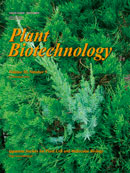30 巻, 5 号
選択された号の論文の13件中1~13を表示しています
- |<
- <
- 1
- >
- >|
Original Papers
-
原稿種別: Original Paper
2013 年 30 巻 5 号 p. 423-431
発行日: 2013/12/25
公開日: 2014/02/01
[早期公開] 公開日: 2013/12/12PDF形式でダウンロード (10072K) -
原稿種別: Original Paper
2013 年 30 巻 5 号 p. 433-446
発行日: 2013/12/25
公開日: 2014/02/01
[早期公開] 公開日: 2013/12/10PDF形式でダウンロード (5374K) -
原稿種別: Original Paper
2013 年 30 巻 5 号 p. 447-453
発行日: 2013/12/25
公開日: 2014/02/01
[早期公開] 公開日: 2013/11/07PDF形式でダウンロード (1090K) -
原稿種別: Original Paper
2013 年 30 巻 5 号 p. 455-464
発行日: 2013/12/25
公開日: 2014/02/01
[早期公開] 公開日: 2013/11/28PDF形式でダウンロード (5111K) -
Root-specific induction of early auxin-responsive genes in Arabidopsis thaliana by cis-cinnamic acid原稿種別: Original Paper
2013 年 30 巻 5 号 p. 465-471
発行日: 2013/12/25
公開日: 2014/02/01
[早期公開] 公開日: 2013/11/14PDF形式でダウンロード (312K) -
原稿種別: Original Paper
2013 年 30 巻 5 号 p. 473-478
発行日: 2013/12/25
公開日: 2014/02/01
[早期公開] 公開日: 2013/11/14PDF形式でダウンロード (4944K) -
原稿種別: Original Paper
2013 年 30 巻 5 号 p. 479-487
発行日: 2013/12/25
公開日: 2014/02/01
[早期公開] 公開日: 2013/11/07PDF形式でダウンロード (782K) -
原稿種別: Original Paper
2013 年 30 巻 5 号 p. 489-496
発行日: 2013/12/25
公開日: 2014/02/01
[早期公開] 公開日: 2013/11/14PDF形式でダウンロード (328K) -
原稿種別: Original Paper
2013 年 30 巻 5 号 p. 497-502
発行日: 2013/12/25
公開日: 2014/02/01
[早期公開] 公開日: 2013/11/20PDF形式でダウンロード (5783K) -
原稿種別: Original Paper
2013 年 30 巻 5 号 p. 503-509
発行日: 2013/12/25
公開日: 2014/02/01
[早期公開] 公開日: 2013/11/23PDF形式でダウンロード (3599K)
Notes
-
原稿種別: Note
2013 年 30 巻 5 号 p. 511-515
発行日: 2013/12/25
公開日: 2014/02/01
[早期公開] 公開日: 2013/11/14PDF形式でダウンロード (532K) -
原稿種別: Note
2013 年 30 巻 5 号 p. 517-521
発行日: 2013/12/25
公開日: 2014/02/01
[早期公開] 公開日: 2013/10/26PDF形式でダウンロード (330K) -
原稿種別: Note
2013 年 30 巻 5 号 p. 523-528
発行日: 2013/12/25
公開日: 2014/02/01
[早期公開] 公開日: 2013/11/14PDF形式でダウンロード (2436K)
- |<
- <
- 1
- >
- >|
